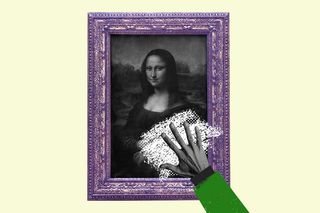
The ‘Mona Lisa’ Was Smeared With Cake As a Mark of Protest
This isn’t the first time that art, and the “Mona Lisa” in particular, has been a subject of socio-political ire.

Here is a series of unfortunate events: a man disguises as an old woman, sits in a wheelchair, visits the Louvre, and attacks one of the most famous paintings in the world with… cake. The motive? To raise awareness about climate change, and point out the systemic lack of willpower to take action.
“While standing near the painting, this individual threw a pastry he had hidden in his personal belongings at the Mona Lisa’s glass case. This act had no effect on the painting, which was not damaged in any way,” a statement by the museum noted.
Vandalism has remained a sure–shot and compelling way to attract attention. An original edition of Auguste Rodin’s The Thinker was defaced in 1970 during a pipe blast by a radical group. In 1974, atthe Museum of Modern Art in New York, a man in broad daylight sprayed the words “Kill all lies” across Pablo Picasso’s anti-war masterpiece, Guernica; it seemed to be an act of protest against the U.S.’s involvement in the Vietnam war.
The Mona Lisa, created in 1503,itself has been the subject of public ire and vandalism (even thievery) more than once. In 1956, someone doused the lower half of the painting in acid; in the same year, a Bolivian national named Ugo Ungaza Villegas threw a rock at the painting, after which,Mona Lisa was put behind a glass-proof frame; in 1974, a woman spray-painted the portrait while at the Tokyo National Museum as an act of protest against the museum’s lack of access for the disabled; and again in 2009, a Russian woman at the Louvre threw a mug at the painting because she was denied French citizenship.
These instances of art vandalism could be read as ferocious protest, or, plain-old absurdity. What we do know is art vandalism has little to do with profit, instead “most often involving a direct attack to message or materiality – for idealogical reasons or, sometimes, for no reason at all,” wrote writer Benedetta Ricci.
It brings to mind the slashing of a Spanish masterpiece in 1914, among the most famous defiant acts led by the women’s suffrage movement. Mary Richardson, a militant suffragette, chose Rokeby Venus by Diego Velázquez to butcher it with a meat cleaver. She said: “I have tried to destroy the picture of the most beautiful woman in mythological history as a protest against the Government for destroying Mrs. Pankhurst [who was arrested the day before], who is the most beautiful character in modern history. Justice is an element of beauty as much as color and outline on canvas.”
Related on The Swaddle:
Tell Me More: Talking Dissent and Hope In Climate Activism With Tamseel Hussain
Even in the current case, the message seems to be of inaction over a looming threat. “Think of the earth, people are destroying the earth,” the man seemingly said.
A natural question to ask here is: is there any substance in drawing attention to causes by way of desecrating art? To be fair, climate change is an issue that threatens human survival, and “climate movements will continue to build in hyper-local regions more frequently, and speaking about climate change will becomemore important — even glamorous in urban spaces,” as sustainable entrepreneur Tamseel Hussain told The Swaddle.
Some would argue it dissolves the message of the protest in bluster, taking away focus from the issue. Anti-war activists opposed the actions of the man who ruined the Guernica, just like some detractors right now find the cake-smashing incident a disservice to the climate awareness messaging. The incident does make headlines owing to its sensationalist nature, but also, any vandalism that is directed at a cultural monolith tends to ruffle people’s sensibilities. The incident is talked about not to lament climate change, but to ridicule the man in a wig, smearing the Mona Lisa smile with decadent cake.
What’s also of note here is the subject matter of public disgruntlement: what makes the Mona Lisa — an artwork just over 2.5 feet tall and under 2 feet wide — a fertile canvas of frequent vandalism? One reason could have to do with Mona Lisa’s celebrity-like status in much of modern memory. This is a celebrity closely interlinked with a nation’s cultural integrity and even its prestige in the world. Any expression of dissent can easily hang its hat on the painting to attract people’s attention. It is similar to how people would deride famous celebrities closely associated with a bigoted government’s politics or those espousing their message. Mona Lisa is not doing either by active choice; it is the placement of the portrait in a national heritage site that makes it an unwitting token of theglobal and national status quo. It is one of the most famous faces in the world, one that could also be a transmitter of any act of protest.
Moreover, the air of mystery that first found space back in the 19th century continues to draw speculation around the origin story of Mona Lisa. There are many good paintings found in several pockets of the world, but there’s only one Mona Lisa with a history at once known and unknown. The French writer Théophile Gautierdescribed her as a “strange being…her gaze promising unknown pleasures,” while others went on about her perfidious lips and enchanting smile. The English author Walter Pater called her a vampire who “has been dead many times, and learned the secrets of the grave.”
The mystique makes the act of vandalism more gripping and astonishing; how could one desecrate this iconic painting, a celebrated writer, and by extension, millions of people who find emotional and artistic meaning in the colors?
Saumya Kalia is an Associate Editor at The Swaddle. Her journalism and writing explore issues of social justice, digital sub-cultures, media ecosystem, literature, and memory as they cut across socio-cultural periods. You can reach her at @Saumya_Kalia.
Related


Kevin Spacey Is Charged With Sexual Assault. Now Is the Perfect Time to Support Male Survivors of Abuse
